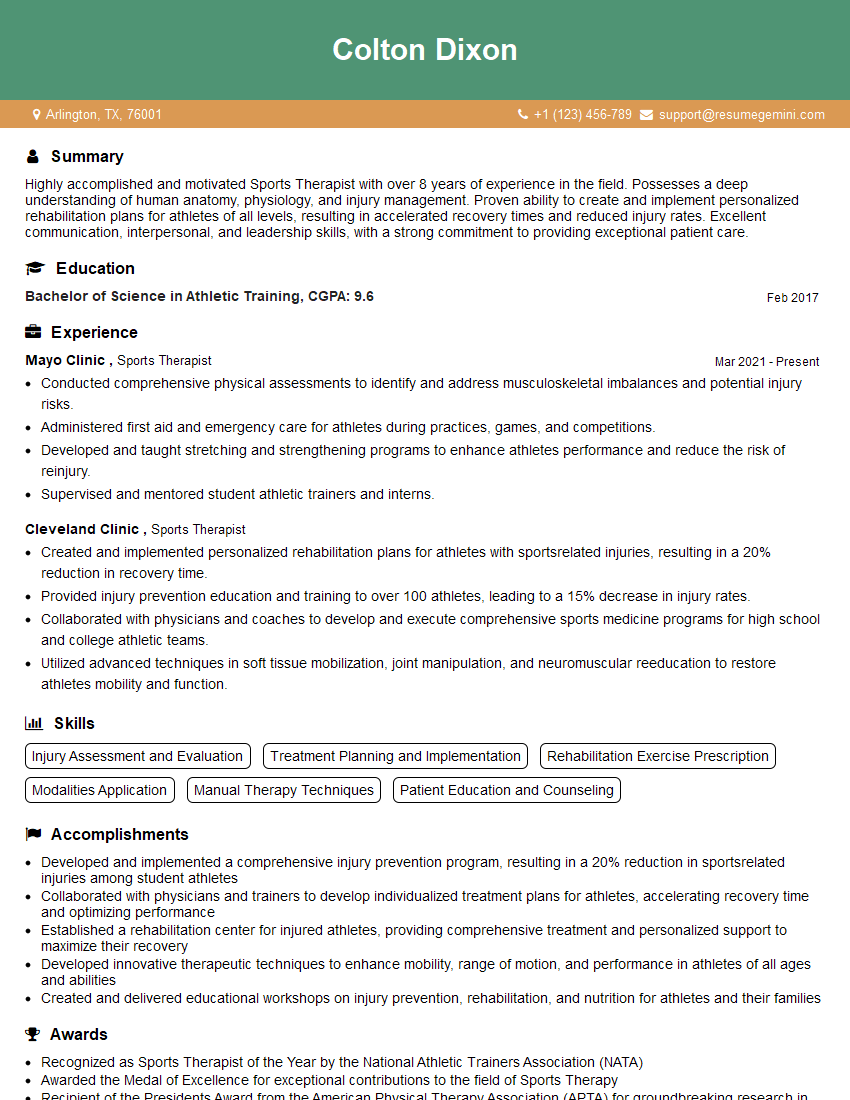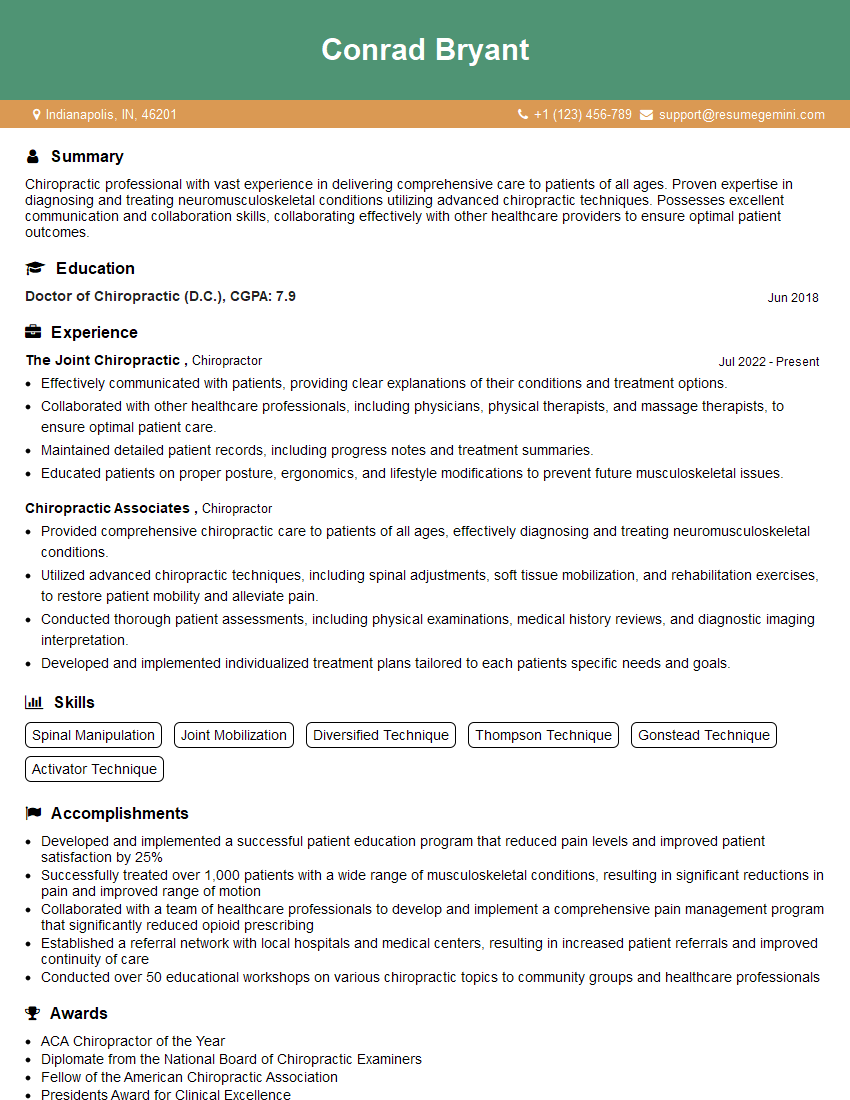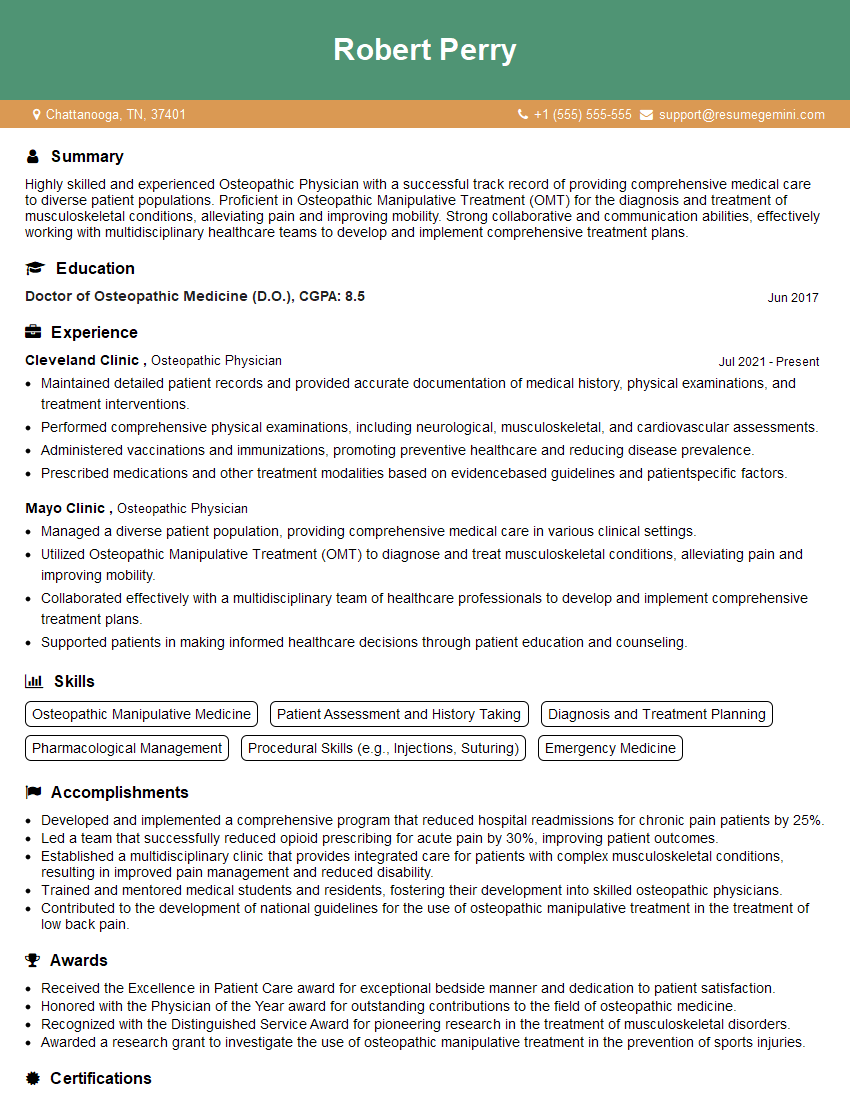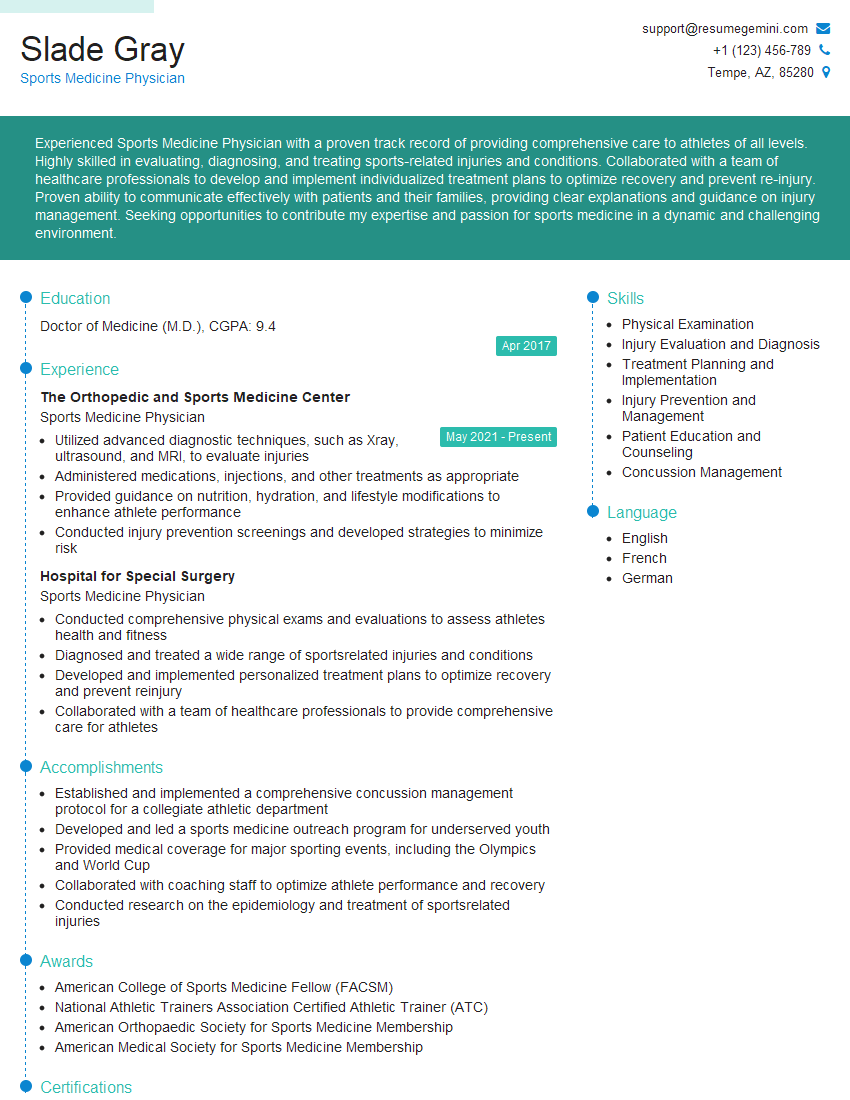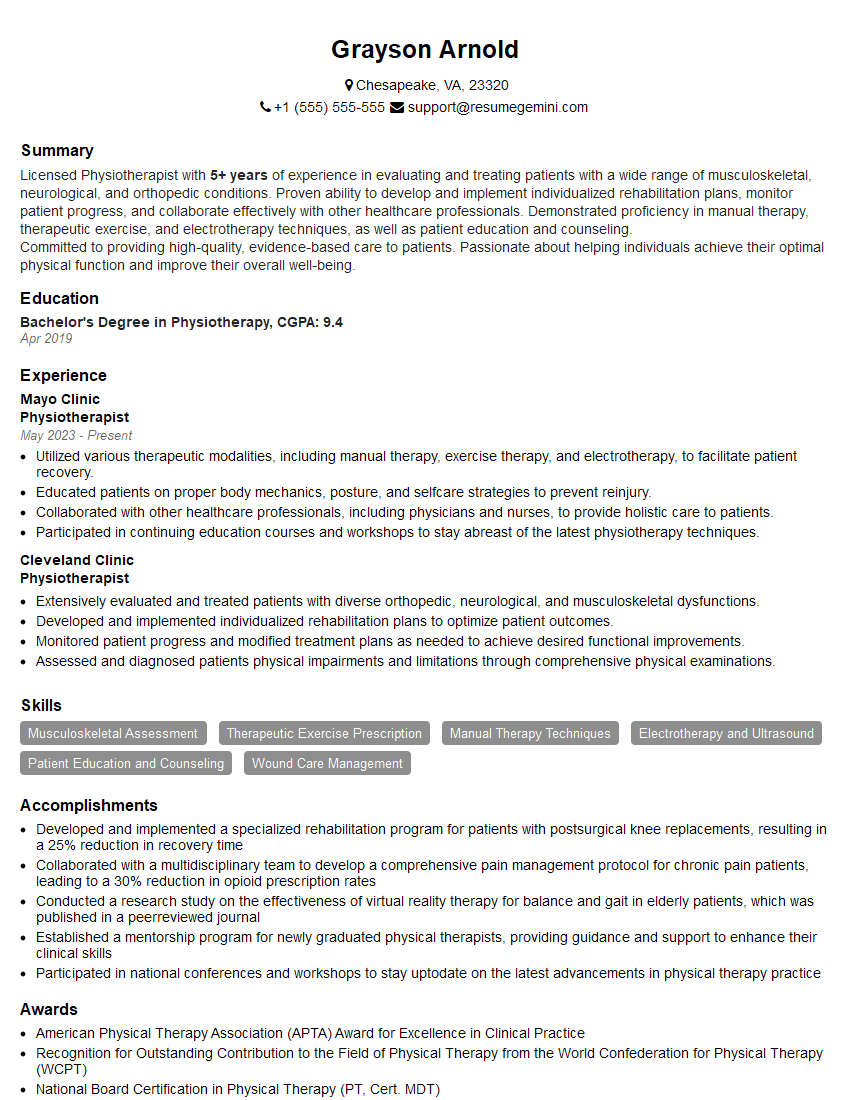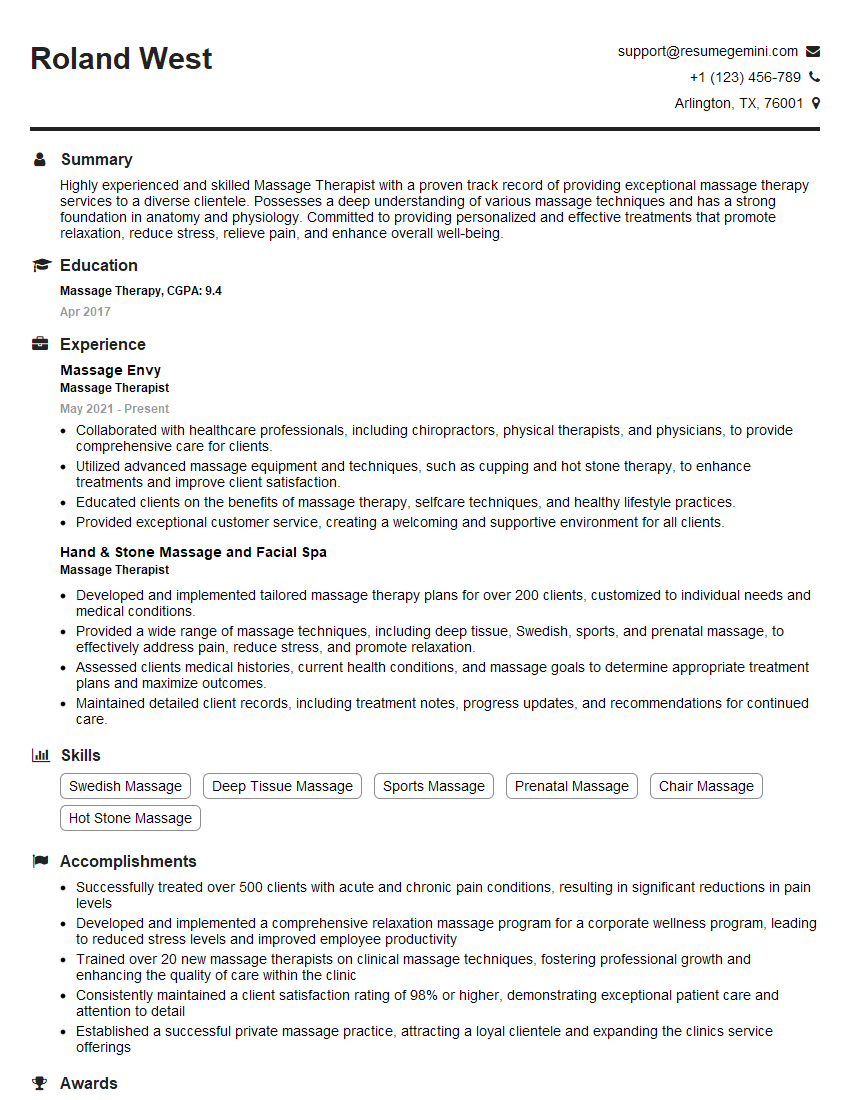The right preparation can turn an interview into an opportunity to showcase your expertise. This guide to Joint Manipulation interview questions is your ultimate resource, providing key insights and tips to help you ace your responses and stand out as a top candidate.
Questions Asked in Joint Manipulation Interview
Q 1. Describe the difference between joint mobilization and manipulation.
Joint mobilization and manipulation are both manual therapy techniques used to improve joint function, but they differ in the amplitude and speed of movement. Mobilization involves applying a small amplitude, oscillatory movement within the physiological range of motion of the joint. Think of it like gently rocking a stiff joint to improve its range. It’s a passive movement performed by the therapist. Manipulation, on the other hand, involves a high-velocity, low-amplitude thrust performed to restore joint motion. It’s a more forceful technique, often resulting in a palpable ‘pop’ or ‘click,’ and aims to break up adhesions and restore normal arthrokinematics (the movement of joint surfaces). Imagine a quick, precise ‘snap’ to release a stuck joint. The key difference lies in the speed and magnitude of the movement, with mobilization being gentler and manipulation being more forceful.
Q 2. Explain the indications and contraindications for joint manipulation.
Indications for joint manipulation often include joint hypomobility (restricted movement), pain arising from joint dysfunction (like facet joint syndrome), and muscle spasm related to joint restriction. For example, manipulation may be indicated for a patient with neck pain stemming from a limited range of motion in the cervical spine. Specific conditions like mechanical neck pain or low back pain often benefit from manipulation when other conservative treatments haven’t provided sufficient relief.
Contraindications are equally crucial. These include conditions like fractures, inflammatory arthritis (like rheumatoid arthritis), osteoporosis (increased risk of fracture), ligament instability, uncontrolled hypertension, pregnancy in certain areas, neurological symptoms (e.g., radiculopathy with significant neurological deficits), and malignancy. Proper assessment is vital to identify these contraindications and ensure patient safety. It’s always important to rule out serious pathology before performing any joint manipulation.
Q 3. What are the different grades of joint mobilization?
Joint mobilization grades are a standardized system for classifying the amplitude and type of movement applied. They typically range from Grade I to Grade V. Grade I involves small amplitude movements at the beginning of the range of motion. Grade II utilizes a larger amplitude movement within the mid-range of motion. Grade III involves a large amplitude movement to the limit of the range of motion. Grade IV is a small amplitude movement at the end of the range of motion. Grade V represents the high-velocity, low-amplitude thrust characteristic of joint manipulation. These grades help therapists choose the appropriate technique based on the patient’s condition and response to treatment. It’s like having a ‘volume dial’ for joint movement, from gentle rocking to a more decisive thrust.
Q 4. How do you assess joint mobility?
Assessing joint mobility involves a thorough evaluation process. This starts with a detailed patient history, followed by a physical examination that includes observation, palpation (feeling the joint), and assessment of active and passive range of motion (AROM and PROM). AROM involves the patient moving the joint themselves, while PROM involves the therapist moving the joint. We also evaluate for pain, muscle guarding, end-feel (the sensation felt at the end of range of motion), and joint sounds (crepitus, clicking). Specific tests might be used depending on the joint in question. For example, assessing the cervical spine might involve testing for range of motion in flexion, extension, lateral bending, and rotation, as well as specific neurological tests.
Active range of motion reveals the patient’s voluntary control of their joints and helps identify any pain or limitations. Passive range of motion helps us identify any restrictions beyond what the patient can actively achieve and gives more information about the nature of joint limitations. Comparing AROM and PROM offers valuable insights into the source of joint dysfunction. This combined approach provides a comprehensive picture of joint mobility and helps determine appropriate treatment strategies.
Q 5. Describe the techniques you use for cervical spine manipulation.
Cervical spine manipulation requires careful technique due to the proximity of vital structures like the brainstem and spinal cord. Techniques vary depending on the specific segment involved. Common approaches include lateral glides, where the therapist applies a side-bending force to a specific vertebra, and rotational manipulations, involving a specific rotation of the head and neck. It is important to note that cervical manipulation should only be performed by skilled clinicians trained in the necessary techniques to minimize the risk of complications. Before attempting any cervical manipulation, a thorough assessment of the patient’s condition must be performed, and any contraindications should be excluded. For example, I would use a specific lateral glide technique to address a hypomobile facet joint in the lower cervical spine while carefully monitoring the patient for any neurological signs during and after the maneuver.
Q 6. Explain your approach to lumbar spine manipulation.
Lumbar spine manipulation often targets specific vertebral segments to restore motion and reduce pain. Common techniques include side-posture manipulations, where the patient lies on their side, and the therapist applies a specific thrust to the affected vertebrae, and prone manipulations, with the patient lying prone (on their stomach). The technique selected depends on the specific diagnosis and the patient’s comfort and tolerance. Again, a thorough assessment must be performed to identify the exact segment(s) affected and to exclude any contraindications. For example, I might use a side-posture manipulation to address a posterior-lateral facet joint restriction in a patient with low back pain, and closely monitor the patient’s response to treatment. Proper stabilization of the lumbar spine is crucial during any manipulation.
Q 7. How do you manage potential risks and complications associated with joint manipulation?
Managing potential risks and complications associated with joint manipulation is paramount. This begins with a thorough assessment, identifying and avoiding contraindications. Techniques must be performed accurately and with the appropriate force. Informed consent is essential, ensuring the patient understands the procedure, its benefits, risks, and potential complications. Possible complications include, but are not limited to: increased pain, nerve root irritation, headache, and, rarely, vertebral artery dissection (though the latter is exceedingly uncommon with proper technique and screening). Post-manipulation monitoring is key, observing for any immediate adverse effects. It’s important to stress the importance of following up with patients, so we can assess their progress and address any concerns. Building a strong therapeutic relationship with the patient fosters open communication, encouraging them to report any symptoms.
Q 8. What are the physiological effects of joint manipulation?
Joint manipulation, also known as spinal manipulation or articulation, aims to restore proper joint mechanics. Its physiological effects are multifaceted and not fully understood, but they likely involve several mechanisms.
Neurological effects: Manipulation can influence the nervous system by reducing muscle spasms, modulating pain signals, and potentially affecting the activity of the autonomic nervous system. Think of it like resetting a jammed computer – a quick adjustment can restore proper function. This can lead to decreased pain perception and improved muscle function.
Mechanoreceptor stimulation: Joint manipulation stimulates mechanoreceptors within the joint capsule and surrounding tissues. These receptors send signals to the brain, potentially inhibiting pain signals and promoting relaxation. It’s like a reset button for the joint’s sensory system.
Biomechanical effects: Manipulation can restore joint range of motion, reduce joint restriction, and improve the alignment of the joint surfaces. This leads to a more efficient movement pattern, akin to lubricating a rusty hinge.
Proprioceptive effects: Manipulation improves the body’s awareness of joint position and movement. This enhanced proprioception leads to better control and coordination, preventing further injuries.
It’s crucial to remember that the exact mechanisms and the extent of the effects vary depending on the individual, the joint involved, and the specific technique used.
Q 9. How do you differentiate between mechanical and non-mechanical pain?
Differentiating between mechanical and non-mechanical pain is critical for effective treatment planning. Mechanical pain is directly related to the musculoskeletal system and is typically reproduced with specific movements or postures. Think of the sharp pain you feel when you twist your ankle – it’s directly linked to the injury.
Mechanical pain often exhibits a clear pattern, is aggravated by specific movements or positions, and improves with rest. For example, lower back pain that worsens with bending and improves when lying down is likely mechanical.
Non-mechanical pain, on the other hand, is not directly related to musculoskeletal structures and is often not reproducible by physical examination. This type of pain can be constant, unrelated to activity, and may be associated with other symptoms, such as fatigue or fever. Conditions like fibromyalgia or cancer pain fall under this category.
A thorough history, physical examination including range of motion testing and palpation, and often imaging studies are crucial for accurate differentiation. This allows for targeted interventions; joint manipulation is generally indicated for mechanical pain but should be avoided or modified for non-mechanical pain.
Q 10. Describe your patient assessment process before performing joint manipulation.
My patient assessment process is comprehensive and begins with a detailed history taking to identify the onset, nature, location, and aggravating/relieving factors of the pain. This helps paint a comprehensive picture of the problem.
Thorough history: I ask about the patient’s medical history, including any previous injuries, surgeries, or existing conditions. I explore their current lifestyle, including activity levels and work-related physical demands.
Physical examination: I perform a thorough musculoskeletal examination, focusing on posture, joint mobility, muscle strength, and neurological function. This includes assessing range of motion, palpation for tenderness, and neurological tests to rule out any nerve involvement.
Special tests: I might use specific tests, such as orthopedic tests, to determine the source of the pain and the presence of any joint restrictions or instability.
Imaging review (if applicable): Radiographic images, such as X-rays or MRIs, help in visualizing potential structural abnormalities that might affect the treatment approach.
This entire process ensures I have a complete understanding of the patient’s condition before considering joint manipulation, and helps determine if it is appropriate and safe.
Q 11. How do you determine the appropriate force and speed for joint manipulation?
Determining the appropriate force and speed for joint manipulation is crucial and depends on several factors. It’s not a ‘one-size-fits-all’ approach.
Patient factors: Age, body size, muscle tone, and the severity of the joint restriction all influence the force needed. A frail elderly patient requires significantly less force than a young, muscular athlete.
Joint-specific factors: Different joints have different tolerance for force and different mobility requirements. A small joint like a finger joint needs a much gentler approach than a large joint like the hip.
Clinical judgment: Years of experience and careful assessment allow me to estimate the appropriate force and speed. This is honed through training and clinical experience; it’s not something that can be taught solely through textbooks.
Patient feedback: Throughout the procedure, I observe the patient’s response, and modify the force and speed based on their comfort and the tissue’s response. It’s a conversation between me and the patient’s body.
Using excessive force can cause injury, while insufficient force may be ineffective. This nuanced approach is paramount for both safety and efficacy.
Q 12. What are the common side effects of joint manipulation, and how do you address them?
While generally safe, joint manipulation can have some side effects, though they are usually temporary and minor.
Temporary soreness or stiffness: This is quite common and usually resolves within a day or two. It’s like the muscle soreness you get after a good workout.
Headache: This is less common but possible, particularly after cervical spine manipulation. It’s usually mild and transient.
Fatigue: Some patients experience temporary fatigue following the treatment, usually resolving within a short period.
Rare complications: In rare cases, more serious complications like nerve irritation, vascular injury, or disc herniation can occur. These are extremely rare with proper technique and careful patient selection.
Addressing these side effects involves thorough communication with the patient, providing post-treatment instructions including rest, ice application, and possibly anti-inflammatory medication if necessary. If any serious complications arise, immediate referral and further investigation is necessary.
Q 13. How do you modify your approach to joint manipulation based on patient age and condition?
Patient age and condition significantly impact my approach to joint manipulation. It’s crucial to adapt the technique to the individual’s needs.
Children: Children’s joints are more flexible, and I use gentler techniques with less force. Their responses differ from adults, and close monitoring for their comfort and responsiveness is vital.
Elderly patients: Elderly patients may have decreased bone density, osteoarthritis, or other age-related conditions that require a more cautious approach. Reduced force and slower speeds are generally employed.
Patients with underlying conditions: Conditions like osteoporosis, rheumatoid arthritis, or pregnancy require modifications to the technique, or in some cases, contraindicate manipulation altogether. This emphasizes the importance of a complete medical history and physical examination.
Patients on medication: Some medications, such as blood thinners, may increase the risk of complications, necessitating adjustments or avoidance of certain techniques.
Careful consideration of these factors is fundamental in ensuring both the safety and efficacy of joint manipulation.
Q 14. Explain the principles of joint mechanics relevant to your practice.
Understanding joint mechanics is fundamental to my practice. It involves the study of how joints move, the forces acting on them, and the factors that influence their function.
Joint structure and function: Each joint has a unique structure, determining its range of motion and stability. Understanding the anatomy of ligaments, tendons, muscles, and joint capsules allows me to target manipulations effectively.
Kinematics: This involves analyzing joint motion, including the type of movement (e.g., flexion, extension, rotation), the range of motion, and the speed of movement. This understanding is essential to correctly assess joint restrictions and perform targeted manipulations.
Kinetics: This branch studies the forces that act on joints, such as muscle forces, gravity, and external loads. Understanding these forces helps in predicting potential stresses on the joints and in selecting appropriate manipulation techniques.
Arthrokinematics: This refers to the movement of joint surfaces relative to one another. Understanding these subtle movements is crucial for accurate diagnosis and treatment of joint restrictions.
Applying these principles in practice helps me diagnose joint dysfunction, plan effective treatment strategies, and achieve optimal outcomes for patients while minimizing the risk of complications.
Q 15. Describe your understanding of joint restrictions and their causes.
Joint restrictions, also known as hypomobility, refer to limitations in the normal range of motion of a joint. These restrictions can manifest as stiffness, pain, and reduced functionality. They arise from a variety of causes, broadly categorized into:
- Musculoskeletal Issues: Muscle spasms, ligamentous tightness, tendinitis, and scar tissue formation can all physically restrict joint movement. Think of a tight hamstring limiting knee extension.
- Joint Pathology: Conditions like osteoarthritis, rheumatoid arthritis, and other inflammatory arthritides cause direct damage to joint structures, leading to reduced mobility and pain.
- Neuromuscular Factors: Muscle guarding (involuntary muscle contraction in response to pain), nerve irritation, and decreased neuromuscular control can all contribute to joint restrictions. For example, nerve root compression can cause muscle spasm and limit spinal movement.
- Postural Deviations: Prolonged postures, like slouching at a desk, can create adaptive shortening in certain muscle groups, leading to joint restrictions. This often manifests as restricted thoracic spine mobility.
- Trauma: Injuries such as sprains, strains, fractures, and dislocations can result in significant joint restrictions, often due to inflammation and scar tissue formation.
Understanding the underlying cause is crucial for effective treatment. A thorough history, physical examination, and potentially imaging studies are necessary to determine the etiology.
Career Expert Tips:
- Ace those interviews! Prepare effectively by reviewing the Top 50 Most Common Interview Questions on ResumeGemini.
- Navigate your job search with confidence! Explore a wide range of Career Tips on ResumeGemini. Learn about common challenges and recommendations to overcome them.
- Craft the perfect resume! Master the Art of Resume Writing with ResumeGemini’s guide. Showcase your unique qualifications and achievements effectively.
- Don’t miss out on holiday savings! Build your dream resume with ResumeGemini’s ATS optimized templates.
Q 16. How do you use palpation to assess joint dysfunction?
Palpation is a cornerstone of joint assessment. It involves using the hands to feel for abnormalities in joint structure and function. My approach is systematic and involves:
- Identifying bony landmarks: Accurately locating anatomical structures provides a reference point for assessing joint mobility.
- Assessing joint play: Gently moving the joint through its range of motion passively helps identify any restrictions or unusual stiffness. I’m looking for any crepitus (grinding or crackling), pain, or resistance.
- Evaluating muscle tension: Palpating muscles around the joint allows me to identify areas of spasm or tightness that may contribute to the restriction. For instance, I might palpate the paraspinal muscles alongside the spine to assess for tightness.
- Detecting soft tissue changes: I carefully assess for swelling, heat, or changes in tissue texture which could indicate inflammation or other pathology.
- Comparing sides: Always comparing the affected side to the unaffected side is crucial to establish a baseline and accurately assess the degree of restriction.
Palpation requires years of practice and a keen sense of touch. It’s an art as much as a science, and combined with a detailed history and other clinical findings, provides a valuable picture of the joint’s condition.
Q 17. What imaging techniques do you find helpful in guiding your decisions related to joint manipulation?
While palpation and clinical examination remain the primary methods for assessing joint dysfunction, imaging techniques play a valuable supporting role. I find the following helpful:
- X-rays: Primarily used to identify bony abnormalities like fractures, osteoarthritis (joint space narrowing, osteophytes), and other degenerative changes. X-rays aren’t as helpful in visualizing soft tissue issues.
- MRI (Magnetic Resonance Imaging): Provides excellent detail of soft tissues, including ligaments, tendons, cartilage, and muscles. It’s crucial for identifying conditions like ligament tears, meniscus injuries, and other soft tissue pathology that may be impacting joint mobility.
- Ultrasound: A useful tool for visualizing soft tissues in real-time, particularly for assessing muscle tension, ligamentous laxity, and fluid collections around a joint. Ultrasound can guide injections as well.
- CT scans (Computed Tomography): Provides detailed images of bone and can be valuable in assessing complex fractures or other bony abnormalities.
The choice of imaging technique depends on the clinical presentation and suspected diagnosis. I use imaging to confirm my clinical findings and guide treatment decisions, but it’s important to remember that imaging findings must always be interpreted within the clinical context.
Q 18. How do you integrate joint manipulation with other therapeutic modalities?
Joint manipulation is rarely used in isolation. It’s most effective when integrated with other therapeutic modalities. This holistic approach addresses the underlying causes of joint restriction and promotes long-term improvement.
- Therapeutic exercise: Strengthening and stretching exercises are crucial for improving muscle balance, flexibility, and neuromuscular control. They help maintain the gains achieved through manipulation.
- Manual therapy techniques: Soft tissue mobilization, muscle energy techniques, and other manual therapy approaches can address muscle tension, improve circulation, and enhance joint mobility before and after manipulation.
- Modalities: Heat, ice, ultrasound, and electrical stimulation can be used to manage pain, reduce inflammation, and promote healing before and after manipulation.
- Patient education: Educating patients about their condition, postural correction, ergonomic adjustments, and self-management techniques is crucial for long-term success.
For example, a patient with lower back pain might receive joint manipulation to address vertebral subluxations, coupled with strengthening exercises for the core muscles, stretches for the hip flexors, and education on proper lifting techniques.
Q 19. Describe a case where joint manipulation was particularly effective.
I recall a patient who presented with acute, severe neck pain following a whiplash injury. She had limited neck rotation and significant pain. After a thorough examination, including palpation which revealed restricted movement at C5-C6, I performed a gentle cervical manipulation. The immediate result was a significant reduction in pain and an increase in range of motion. Combined with a home exercise program emphasizing neck stretches and strengthening exercises, her pain resolved within a week, and full range of motion was restored within a month. This case highlighted the effectiveness of joint manipulation in addressing acute musculoskeletal pain and restoring joint mechanics.
Q 20. Describe a case where joint manipulation was not effective, and how you adapted your approach.
A patient with chronic lower back pain and suspected facet joint syndrome didn’t respond well to several joint manipulation sessions. While palpation initially suggested joint restriction, the pain persisted. I realized that the primary issue wasn’t solely mechanical. I adapted my approach by incorporating other modalities, focusing on soft tissue work to address muscle tightness in the lumbar and gluteal regions. We also incorporated stabilization exercises and a graded activity program. It turned out that the primary issue was muscle-related pain and compensation patterns rather than purely mechanical joint dysfunction. This case emphasized the importance of considering multiple contributing factors and adapting treatment plans accordingly, demonstrating the limitations of joint manipulation in isolation.
Q 21. What are the ethical considerations in performing joint manipulation?
Ethical considerations in performing joint manipulation are paramount. Key aspects include:
- Informed consent: Patients must fully understand the procedure, its potential benefits and risks, and alternative treatments before consenting. They need to feel empowered to make informed choices.
- Accurate diagnosis: Joint manipulation should only be performed after a thorough assessment and accurate diagnosis. Incorrect application can lead to harm.
- Appropriate indications: Joint manipulation should only be used for appropriate conditions. It’s not suitable for all musculoskeletal problems.
- Proper technique: The practitioner must possess the necessary skills and knowledge to perform the manipulation safely and effectively. Continuing education is crucial.
- Referral when necessary: If a condition is beyond the scope of joint manipulation or requires further investigation, appropriate referral to other specialists is vital.
- Ongoing monitoring: Following the manipulation, monitoring the patient’s response is crucial. If there are adverse effects, appropriate action must be taken immediately.
Adhering to these ethical principles ensures patient safety and fosters trust between the practitioner and the patient.
Q 22. How do you obtain informed consent from your patients before performing joint manipulation?
Obtaining informed consent for joint manipulation is paramount. It’s not just a legal requirement; it’s about building trust and ensuring the patient is an active participant in their care. I begin by explaining the procedure in clear, non-technical language, tailored to the patient’s understanding. I describe what I’ll be doing, the expected benefits, potential risks (such as temporary discomfort or bruising), and alternative treatment options. I also emphasize that they have the right to refuse the treatment at any point, without penalty. I use a combination of verbal explanation and a written consent form that outlines all these points. For instance, if I’m treating a patient with neck pain, I might explain that a specific joint manipulation technique will aim to restore proper movement and reduce pain, but there’s a small chance of feeling some temporary soreness afterwards. The written form ensures a record of this discussion and the patient’s agreement. I make sure all questions are answered thoroughly before obtaining their signature.
Q 23. How do you document your joint manipulation treatments?
Thorough documentation is crucial for legal protection and continuity of care. My documentation for each joint manipulation treatment includes the patient’s identifying information, the date and time of the treatment, the specific joint(s) manipulated, the technique(s) used (e.g., HVLA thrust, mobilization), the patient’s presentation before and after the treatment (including pain levels, range of motion, and any other relevant observations), and my assessment of the patient’s response to the treatment. I note any relevant precautions taken and any adverse events or complications. For example, if I used a high-velocity, low-amplitude (HVLA) thrust on a patient’s cervical spine, I’d document the specific technique, the exact position, and the patient’s response. I also document the patient’s feedback and any home exercise program prescribed to support the effects of the manipulation. All of this is meticulously recorded in the patient’s electronic health record.
Q 24. What continuing education have you undertaken in joint manipulation techniques?
Continuing education is a cornerstone of my practice. I regularly attend workshops and conferences focused on musculoskeletal manipulation. I’ve completed advanced training in spinal manipulation and extremity joint manipulation, including courses certified by organizations such as the [Insert relevant certifying organization, e.g., American Academy of Orthopaedic Manual Physical Therapists]. Recently, I participated in a seminar on the integration of joint manipulation with other manual therapy techniques, like soft tissue mobilization, to optimize treatment outcomes. My focus has been on refining my skills in specific techniques, such as mobilization with movement (MWM) and understanding the biomechanics underlying joint restrictions.
Q 25. How do you stay updated on the latest research and best practices in joint manipulation?
Staying current in this rapidly evolving field involves a multi-pronged approach. I regularly read peer-reviewed journals like the Journal of Manual & Manipulative Therapy and other relevant publications. I am a member of professional organizations like the [Insert relevant professional organization, e.g., American Physical Therapy Association], which provides access to the latest research and best practice guidelines through webinars, newsletters, and conferences. I also actively participate in continuing education courses and workshops presented by leading experts in joint manipulation. Regularly searching reputable databases like PubMed helps me stay on top of the latest research on efficacy, safety, and indications for joint manipulation techniques.
Q 26. Describe your experience with different types of joint manipulation techniques (e.g., HVLA, mobilization).
My experience encompasses a wide range of joint manipulation techniques. I’m proficient in both high-velocity, low-amplitude (HVLA) thrust techniques and mobilization techniques. HVLA is used for addressing joint restrictions with a quick, precise movement. This is particularly useful for addressing joint fixations where there is a sudden, noticeable restriction. Mobilization, on the other hand, involves slower, smaller movements, often used for patients with acute injuries or those who are more sensitive to HVLA. I select the technique based on the patient’s individual needs, the specific joint involved, the nature of the restriction, and their tolerance. For example, I might use HVLA on a patient with a locked-up facet joint in the lumbar spine, while using mobilization for a patient with recent whiplash injury. I also utilize various mobilization grades (I-IV), adjusting the amplitude and speed to match the patient’s response.
Q 27. How do you assess patient progress following joint manipulation?
Assessing patient progress after joint manipulation is a multi-faceted process. I use a combination of objective and subjective measures. Objective measures include range of motion assessment using goniometry, muscle strength testing, and functional tests specific to the affected joint and activity. Subjective measures involve asking the patient about their pain levels (using a numerical rating scale or visual analog scale), their functional capacity, and their overall sense of improvement. I also assess for any changes in posture or gait. For instance, if I treated a patient with limited shoulder flexion due to a frozen shoulder, I’d measure their range of motion pre- and post-treatment using a goniometer and then re-assess it at subsequent follow-up appointments. I’d also monitor their pain levels and observe their ability to perform activities of daily living, like reaching overhead, to gauge their overall improvement.
Q 28. What are the limitations of joint manipulation?
While joint manipulation is a valuable tool, it’s important to acknowledge its limitations. It’s not appropriate for all patients or conditions. Conditions such as osteoporosis, rheumatoid arthritis in its active phase, certain types of fractures, and severe ligamentous instability are contraindications. Additionally, it’s not a stand-alone solution. It’s most effective when combined with other interventions, such as therapeutic exercise, patient education, and lifestyle modifications. Another limitation is that the effects may not be immediate or long-lasting for all patients. A comprehensive assessment is crucial to determine suitability and to avoid potential risks and complications. Finally, some patients may experience temporary discomfort or adverse effects, highlighting the importance of thorough informed consent and careful technique.
Key Topics to Learn for Joint Manipulation Interview
- Biomechanics of Joint Manipulation: Understanding joint structure, movement, and the forces involved in manipulation techniques.
- Indications and Contraindications: Mastering the criteria for appropriate and inappropriate application of joint manipulation, including patient assessment and risk stratification.
- Specific Manipulation Techniques: Thorough knowledge of various mobilization and manipulation techniques for different joints (e.g., cervical, thoracic, lumbar spine, extremities).
- Patient Positioning and Handling: Safe and effective patient positioning and handling procedures to ensure optimal treatment outcomes and minimize risks.
- Neurological Considerations: Understanding the neurological implications of joint manipulation and the potential for both positive and negative effects.
- Therapeutic Exercise and Rehabilitation: Integrating joint manipulation with other therapeutic interventions for comprehensive patient care and improved functional outcomes.
- Assessment and Diagnosis: Developing skills in accurately assessing musculoskeletal dysfunction and using appropriate diagnostic reasoning to determine the suitability of joint manipulation.
- Documentation and Communication: Clear and concise documentation of treatment plans, progress, and any complications arising from joint manipulation techniques. Effective communication with patients and other healthcare professionals.
- Ethical Considerations: Understanding the ethical implications of joint manipulation, including informed consent and professional boundaries.
- Research and Evidence-Based Practice: Staying current with the latest research and evidence-based practices related to joint manipulation techniques and their effectiveness.
Next Steps
Mastering Joint Manipulation opens doors to exciting career opportunities and allows you to make a real difference in patients’ lives. To significantly boost your job prospects, crafting an ATS-friendly resume is crucial. A well-structured resume highlights your skills and experience effectively, ensuring your application gets noticed. We recommend using ResumeGemini, a trusted resource for building professional resumes. ResumeGemini provides examples of resumes tailored to the Joint Manipulation field, helping you showcase your expertise and land your dream job. Take the next step and build a resume that reflects your unique qualifications and experience in Joint Manipulation.
Explore more articles
Users Rating of Our Blogs
Share Your Experience
We value your feedback! Please rate our content and share your thoughts (optional).
What Readers Say About Our Blog
This was kind of a unique content I found around the specialized skills. Very helpful questions and good detailed answers.
Very Helpful blog, thank you Interviewgemini team.
